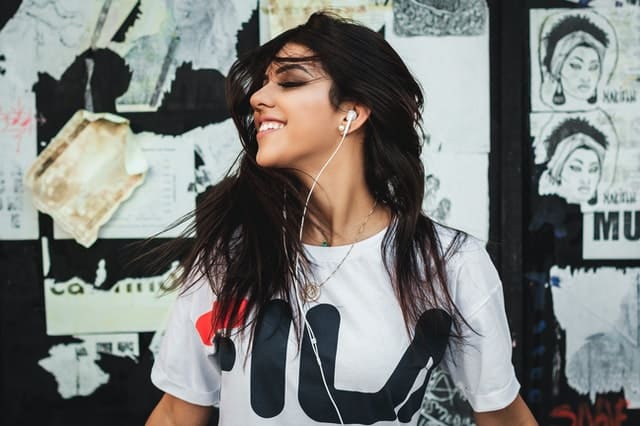It’s almost impossible to picture a world where fashion & music don’t go together. Music significantly affects our lives and defines the times we’re living in. Throughout history, music’s influence on fashion has been evident. Like fashion, music is a form of self-expression. Both concepts can be pretty emotional and are art forms the audience can enjoy and indulge in. Like music, fashion signifies our times and tells us much about our history. Many would argue that fashion & music became so connected because they’re both a method of expressing individuality, ideas, and political belief. In almost every decade, we can easily see how music influenced fashion.
Some of the influences of the connection between fashion and music are memorable creations for music videos, while others become late fashion trends. Music celebrities and fashion designers have continually altered the course of fashion through this relationship. The effect is immense and has birthed some of today’s best fashion pieces. Most musicians act as muses for fashion designers who tap into their musical representation for reference points used for widespread interpretation.
Fashion Designers Who Drew Their Inspiration From Music
It’s no surprise that the two concepts go intricately. Several fashion designers have created iconic pieces for their favorite artists over the years. This section of the article also explores how designers created inspiration from music.
John Varvados
This designer is one of those who were socially conscious. His menswear line features tees, leather jackets, boots, and so much more. In the last decade, he has often served as the spokesperson for the brand. Varvados had his label to sign an artist he wanted to promote. In addition, his New York flagship store also eased the old CBGB building, so the music connections ran deep.
Vivienne Westwood
It would be challenging to mention the music-influenced fashion designers without mentioning Vivienne Westwood. She is a part of creating punk fashion and dressed the sex pistols for the two years they were together. From her time working with Malcolm McLaren at their London Shop, she constantly pushed her style and continually pushed it long after punk became mainstream. Her early style influences fashion today, as shown in Pharrell William’s ‘Buffalo Girls’ hat.
Gucci
David Bowie has continued to be a touchstone for many designers since the early 70s. Gucci is one of the top designers that viewed him as a muse. When he walked around in garments, he named man’s dresses and traded his long locks for ziggy stardust’s red shag. He paid David Bowie tribute in his fall 2006 collection. He shared that while creating the collection, he thought of how people played with their image to be different each time they went out in the seventies.
Marc Jacob
Marc Jacob was also at the forefront of music fashion. He played a role in bringing grunge style to the masses in 1992. He also made the cheap clothing of the era into high-quality haute couture. Marc Jacobs has been working with musicians like Miley Cyrus and Kanye West. Jacob put together a music video with Director William during his runway show. Additionally, we could see Courtney Love, St Vincent, Missy Elliot, and Marilyn Manson in the video. He was also one of the first designers to work with Apple Music on their fashion music channel.
Tommy Hilfiger
Tommy Hilfiger’s work caught on with the hip-hop community in 1990. However, his music root goes much deeper than that. You could find fashion & music in Tommy Hilfiger, and he sponsored top artists like Rolling Stone. He readily welcomed it when hip hop embraced him and used artists like Usher in his ads. He was dressed Snoop Dogg for ‘Saturday Night Life.’ This designer is still quite popular with artists like Rihanna, and he creates retro designs that mimic his 90’s pieces.
Alexander Wang
Wang once shared that his love for hip hop inspired his style as a youth. Now he draws inspiration from music as a designer. He was the first designer apple used for the fashion music channel. We also put together a music video ad for his 2016 line ad. This ad featured an unheard Skrillex track, and there were also some punk-inspired threads.
Balmain
The appreciation between fashion & music was evident with this brand. Balmain’s Christophe Decarnin didn’t just create one line inspired by Michael Jackson. Instead, there were hips of this pop king in all of the designer’s shows. This ranged from studded jackets to military blazers to bright leather pants. Many times, Decarnin credited Jackson’s influence for refreshing the Balmain brand. Jackson often wore a Balmain t-shirt straight from the Fall 2009 collection.
These designers proved how well fashion & music worked together. From the counterculture to mainstream music, music has inspired designers for decades.
Music’s Influence Over Fashion
Music’s influence over fashion has become apparent over the years, and we’ll be reviewing them in this section.
Bobby Soxers
With rock and roll’s birth in 1951, youth culture and several other cultures gained momentum. The American teenage girls known as bobbysoxers gained fame in the 1940s for their fashion and adulation of Frank Sinatra. Bobby wore ankle socks, denim rolled-up jeans, poodle skirts, hair ribbons, and blouses with small flounced edging. Bobby Soxers were relatively rare in the music fashion cultures because males were responsible for leading innovation.
Mods
The idea of inter-group identifications was crucial to the Mods. The Mods were formed in Britain in 1965 and influenced menswear and fashion. Most of them sited themselves in an urban backdrop of expression bars, mini motorcars, and a backdrop of Perry Como and the French Look. It was greatly influenced by the movie ‘Shoot the Pianist’ shot in 1960. Mods also wore American army parkas over American shirts and had tailored suits.
Most of the Mod’s allure was that fashion designers like Pierre Cardin applied it to their work. There were graphic symbols like Union Jacks, cycling images, targets, and many more that mods, artists, and fashion designers found appealing. Although Mods were mostly teenage groups with different interests, they were also sound sophisticates who rejected traditional music and focused on modern jazz, rhythm, and blues. They were passionate stylists that understood that change already existed.
It wasn’t till the 1980s that the Jam showed the difference between the old and new Mod. The music from this era became aggressive and trashy while the looks were stereotypical items already diluted by other bands. The legacy continued until it began to assume cross-cultural references.
Retro-Futurism and Neoclassicism
Kraftwerk’s German band underwrote the creative disposition for many British bands and musical styles. This German band was influenced by Italian futurism, and their music covered electronic minimalism. Their beats defined a soundscape that challenged the concept of music in ways that John Cage’s ideas about noise, silence, and music did. In early 1980, Versace, Theirry Mugler, and Montana used motifs that displayed monochromatic uniformity. Fashion shops like PX and Plaza in London demonstrated how fashion synchronizes with music.
Anthony Price’s uniforms worn by Kraftwerk were inseparable from his menswear. His shop was one of the most innovative concepts of its days. It made it clear how fashion & music were linked. Anthony Price referenced the retro-futuristic trend. Outside, people could see a waist of view of two android-like shop dummies standing behind the shop window. These were a reference to neoclassicism and retro-futurism. Joy Division, New Order, and Roxy music’s album cover referenced neoclassicism. In addition, Kraftwerk influenced artists like Ultravox and David Bowie and styled themselves in celebration of the futurist.
Rave
Techno music is also an inheritance from Kraftwerk’s music. In the late 1980s, the British rave became a product of Techno. Rave was a loose symbiosis of Balearic Beat, Chicago House, and Electro. It started as the Acid House in Manchester and then grew as the second ‘summer of love’ This label was applied to the period that welcomed the drug ecstasy.
Known for impromptu actions at service stations and farmlands, raves were popular for ecstasy, which became a part of the movement. The hypnotic bleeps and hooks of Techno drew in diverse followers from different social spectrums. Despite an indefinable constituency, rave defined itself as a fashion expression. Girls began to wear tight leather pants, fitted t-shirts, waistcoats, and long-sleeved jerkins. Some accessories accompanying this look were silver rings, silver bracelets, friendship bracelets, and other wristbands popular with hippies.
Boys were harder to define in this fashion & music connection, although they wore fashion by leading designers like Armand Basi, Paul Smith, C.P Company, and many more. Most times, the boy’s clothes consisted of polo shirts, jeans, anorak, t-shirts, and similar fashion. The clubwear designer label came of age in 1987, but they were primarily cheap and poorly made clothes. However, Rave followers found it perfect as they loved to wear different clothes to party each weekend.
Hip Hop and Rastafariance
There were times when fashion drew inspiration directly from music culture. Additionally, Rastafarian music created a popular culture that you could apply in different forms. Fashion was a consistent interpreter of the Rastafari’s fashion display. Companies like Complice, Rifat Ozbek, and more used the symbolism of Rastafarianism, dreadlocked hair, and their khaki uniform in what the press called an international ethno-chic. In the summer 2000 advertisement, Versace Jean Couture showed white models wearing heavy gold neck chains, while the male model wore a gold tooth and low-slung jeans. The grittiness of hip-hop fashion was sanitized, reconstituted, and made available for the mainstream here.
Final Thoughts
Fashion & music continuously create similar themes, which motivates reactions in both aspects. There have been many signs of music’s influence over fashion over the decades, which continues into today. However, fashion also influenced music over the years, as is portrayed in punk rock, which was the most exciting collaboration of fashion & music. Music and fashion connection continue to catalyze the way people create and interact with music and fashion.








